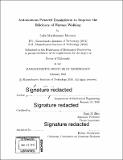Autonomous powered exoskeleton to improve the efficiency of human walking
Author(s)
Mooney, Luke Matthewson
DownloadFull printable version (13.05Mb)
Other Contributors
Massachusetts Institute of Technology. Department of Mechanical Engineering.
Advisor
Hugh M. Herr.
Terms of use
Metadata
Show full item recordAbstract
For over a century, technologists have strived to develop autonomous leg exoskeletons that reduce the metabolic energy consumed when humans walk and run, but such technologies have traditionally remained unachievable. In this thesis, I present the Augmentation Factor, a simple model that predicts the metabolic impact of lower limb exoskeletons during walking. The Augmentation Factor balances the benefits of positive exoskeletal mechanical power with the costs of mechanical power dissipation and added limb mass. These insights were used to design and develop an autonomous powered ankle exoskeleton. A lightweight electric actuator mounted on the lower-leg provides mechanical assistance to the ankle during powered plantar flexion. Use of the exoskeleton significantly reduced the metabolic cost of walking by 11 ± 4% (p = 0.019) compared to walking without the device. In a separate study, use of the exoskeleton reduced the metabolic cost of walking with a 23 kg weighted vest by 8 ± 3% (p = 0.012). A biomechanical study revealed that the powered ankle exoskeleton does not simply replace ankle function, but augments the biological ankle while assisting the knee and hip. Use of the powered ankle exoskeleton was shown to significantly reduced the mean positive power of the biological ankle by 0.033 ± 0.006 W/kg (p<0.01), the knee by 0.042 ± 0.015 W/kg (p = 0.02), and the hip by 0.034 ± 0.009 W/kg (p<0.01). The Augmentation Factor was used to unify the results of the presented devices with the metabolic impacts of previous exoskeletons from literature. In the design of leg exoskeletons, this thesis underscores the importance of minimizing exoskeletal power dissipation and added limb mass, while providing substantial positive power to a walking human. These design requirements were used to develop the first autonomous exoskeleton to reduce the metabolic cost of walking.
Description
Thesis: Ph. D., Massachusetts Institute of Technology, Department of Mechanical Engineering, 2016. Cataloged from PDF version of thesis. Includes bibliographical references (pages 141-145).
Date issued
2016Department
Massachusetts Institute of Technology. Department of Mechanical EngineeringPublisher
Massachusetts Institute of Technology
Keywords
Mechanical Engineering.